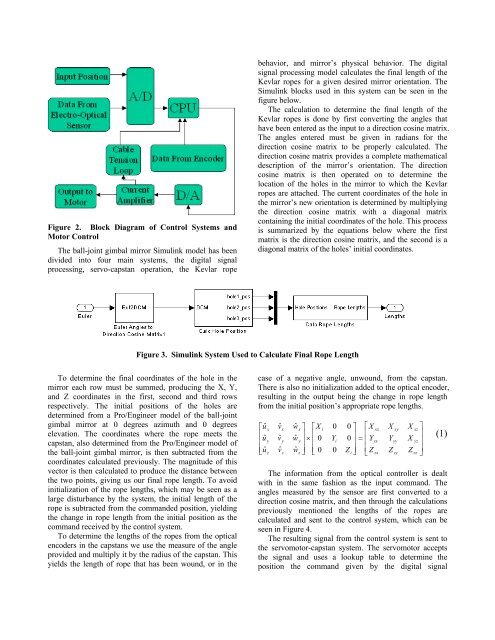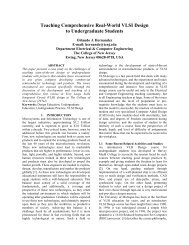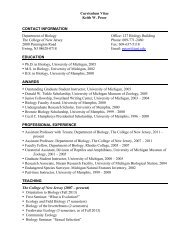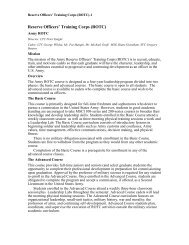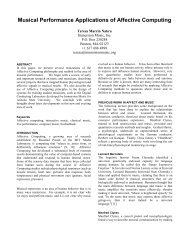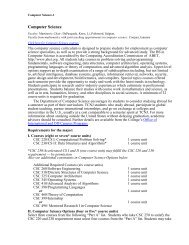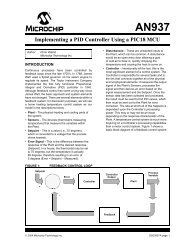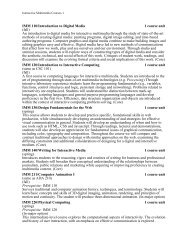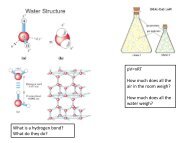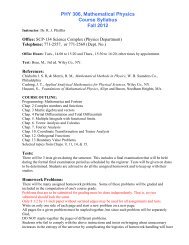Precision Stabilization Simulation of a Ball Joint Gimbaled Mirror ...
Precision Stabilization Simulation of a Ball Joint Gimbaled Mirror ...
Precision Stabilization Simulation of a Ball Joint Gimbaled Mirror ...
You also want an ePaper? Increase the reach of your titles
YUMPU automatically turns print PDFs into web optimized ePapers that Google loves.
Figure 2. Block Diagram <strong>of</strong> Control Systems and<br />
Motor Control<br />
The ball-joint gimbal mirror Simulink model has been<br />
divided into four main systems, the digital signal<br />
processing, servo-capstan operation, the Kevlar rope<br />
behavior, and mirror’s physical behavior. The digital<br />
signal processing model calculates the final length <strong>of</strong> the<br />
Kevlar ropes for a given desired mirror orientation. The<br />
Simulink blocks used in this system can be seen in the<br />
figure below.<br />
The calculation to determine the final length <strong>of</strong> the<br />
Kevlar ropes is done by first converting the angles that<br />
have been entered as the input to a direction cosine matrix.<br />
The angles entered must be given in radians for the<br />
direction cosine matrix to be properly calculated. The<br />
direction cosine matrix provides a complete mathematical<br />
description <strong>of</strong> the mirror’s orientation. The direction<br />
cosine matrix is then operated on to determine the<br />
location <strong>of</strong> the holes in the mirror to which the Kevlar<br />
ropes are attached. The current coordinates <strong>of</strong> the hole in<br />
the mirror’s new orientation is determined by multiplying<br />
the direction cosine matrix with a diagonal matrix<br />
containing the initial coordinates <strong>of</strong> the hole. This process<br />
is summarized by the equations below where the first<br />
matrix is the direction cosine matrix, and the second is a<br />
diagonal matrix <strong>of</strong> the holes’ initial coordinates.<br />
Figure 3. Simulink System Used to Calculate Final Rope Length<br />
To determine the final coordinates <strong>of</strong> the hole in the<br />
mirror each row must be summed, producing the X, Y,<br />
and Z coordinates in the first, second and third rows<br />
respectively. The initial positions <strong>of</strong> the holes are<br />
determined from a Pro/Engineer model <strong>of</strong> the ball-joint<br />
gimbal mirror at 0 degrees azimuth and 0 degrees<br />
elevation. The coordinates where the rope meets the<br />
capstan, also determined from the Pro/Engineer model <strong>of</strong><br />
the ball-joint gimbal mirror, is then subtracted from the<br />
coordinates calculated previously. The magnitude <strong>of</strong> this<br />
vector is then calculated to produce the distance between<br />
the two points, giving us our final rope length. To avoid<br />
initialization <strong>of</strong> the rope lengths, which may be seen as a<br />
large disturbance by the system, the initial length <strong>of</strong> the<br />
rope is subtracted from the commanded position, yielding<br />
the change in rope length from the initial position as the<br />
command received by the control system.<br />
To determine the lengths <strong>of</strong> the ropes from the optical<br />
encoders in the capstans we use the measure <strong>of</strong> the angle<br />
provided and multiply it by the radius <strong>of</strong> the capstan. This<br />
yields the length <strong>of</strong> rope that has been wound, or in the<br />
case <strong>of</strong> a negative angle, unwound, from the capstan.<br />
There is also no initialization added to the optical encoder,<br />
resulting in the output being the change in rope length<br />
from the initial position’s appropriate rope lengths.<br />
⎡uˆ<br />
⎢<br />
⎢<br />
uˆ<br />
⎢⎣<br />
uˆ<br />
x<br />
y<br />
z<br />
vˆ<br />
x<br />
vˆ<br />
y<br />
vˆ<br />
z<br />
wˆ<br />
x ⎤ ⎡X<br />
i<br />
wˆ<br />
⎥<br />
×<br />
⎢<br />
y<br />
⎥ ⎢<br />
0<br />
wˆ<br />
⎥⎦<br />
⎢<br />
z ⎣ 0<br />
0<br />
Y<br />
i<br />
0<br />
0 ⎤ ⎡X<br />
⎢<br />
0<br />
⎥<br />
⎥<br />
= ⎢ Y<br />
Z ⎥⎦<br />
⎢<br />
i ⎣ Z<br />
xx<br />
yx<br />
zx<br />
X<br />
Y<br />
Z<br />
xy<br />
yy<br />
zy<br />
X<br />
X<br />
Z<br />
xz<br />
yz<br />
zz<br />
⎤<br />
⎥<br />
⎥<br />
⎥<br />
⎦<br />
(1)<br />
The information from the optical controller is dealt<br />
with in the same fashion as the input command. The<br />
angles measured by the sensor are first converted to a<br />
direction cosine matrix, and then through the calculations<br />
previously mentioned the lengths <strong>of</strong> the ropes are<br />
calculated and sent to the control system, which can be<br />
seen in Figure 4.<br />
The resulting signal from the control system is sent to<br />
the servomotor-capstan system. The servomotor accepts<br />
the signal and uses a lookup table to determine the<br />
position the command given by the digital signal


